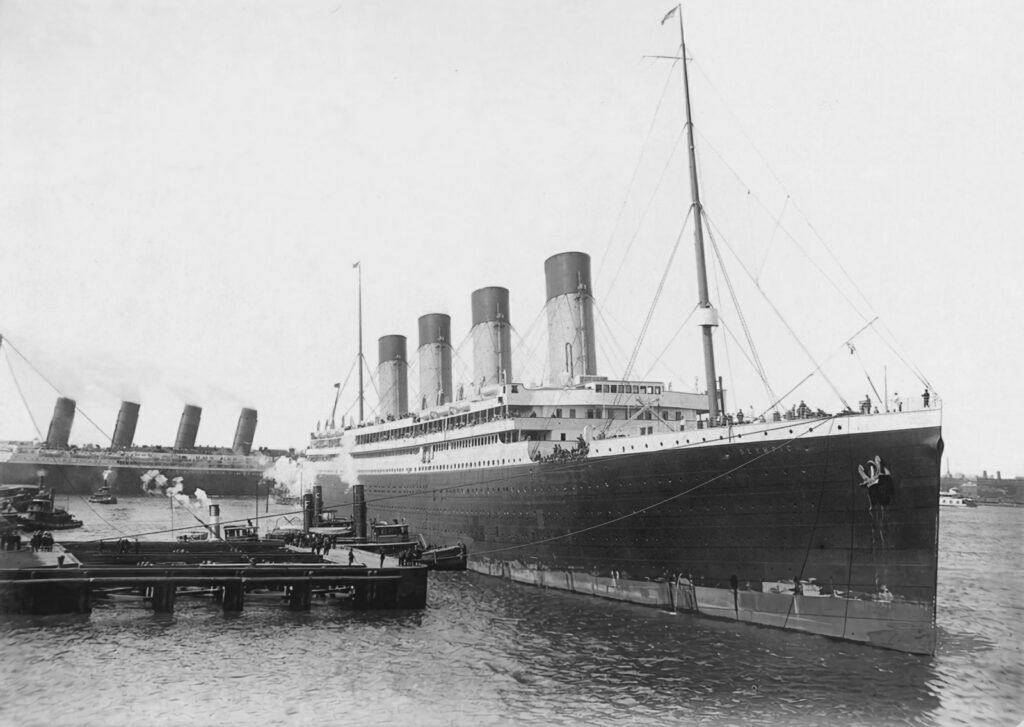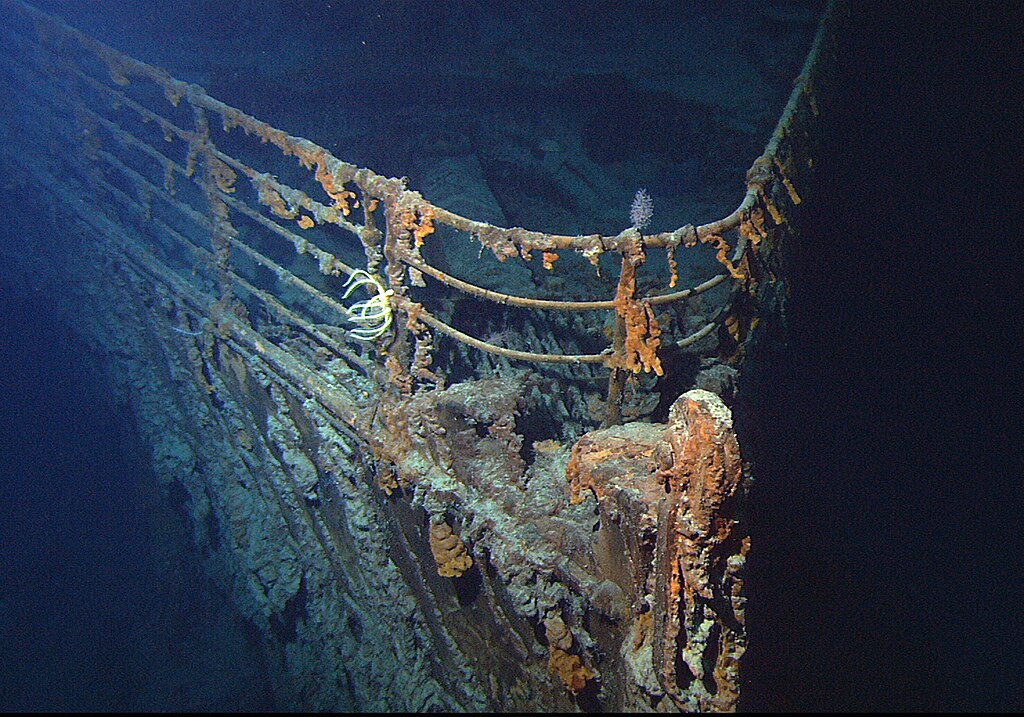In 1997, James Cameron released his three-hour tragic romance about a doomed relationship between a working-class man from Wisconsin and a well-to-do young woman from Philadelphia, set against the backdrop of a fictionalised telling of the sinking of the Titanic.
The success of the film spawned months of Titanic-mania. For a while, it seemed like everyone was talking about the Titanic. Talking about the disaster itself, or the film, debating its accuracy (or lack thereof), the huge budget, the lavish sets, and the controversial decision to depict the ship breaking in half as it sank.
In the wake of this, Robin Gardiner wrote what would become a bestselling book: ‘Titanic: The Ship That Never Sank.’ Gardiner, a plasterer from Oxford with a lifelong interest in maritime history, puts forward a conspiracy theory that claims the ship currently sitting at the bottom of the Atlantic is not the Titanic at all. Rather it is Titanic’s sister ship, RMS Olympic.
He claims that the two vessels were secretly switched as part of an elaborate insurance fraud scheme; the real Titanic was renamed Olympic and went on to serve a respectable 25-year career, while the original Olympic (now badged ‘Titanic’) was deliberately scuttled to claim the insurance.
Olympic and Titanic were built almost simultaneously by the Belfast shipbuilders Harland and Wolff on behalf of the White Star Line, a major shipping company based in Liverpool. A third ship in the class, Britannic, was constructed later.

While RMS Olympic was the first to be completed, launching on 20 October 1910, disaster struck less than a year later. On 20 September 1911, while under the command of Captain Edward Smith, Olympic collided with HMS Hawke, a British warship, off the Isle of Wight. The Hawke’s reinforced ram tore badly into the Olympic’s hull, tearing two large holes in the hull and flooding two watertight compartments.
The subsequent investigation found the Olympic, and therefore the White Star Line, culpable for the collision. Accordingly, the insurance firm Lloyds of London refused to pay out for the damage to the Olympic. This left the company to pay for the repairs to the Olympic, cover legal expenses from the dispute with the Royal Navy, while also losing revenue while its flagship was out of service.
So, a plan was hatched. White Star would secretly rename the nearly-completed Titanic to ‘Olympic’ and rush it into service. Meanwhile, the damaged Olympic would be patched up and disguised as the Titanic, with the intention of staging an ‘accident’ during what would be promoted as the Titanic’s maiden voyage. Lloyds would pay out on the sinking of what they thought was Titanic, but was actually the damaged Olympic.
To pull this off, all they had to do was re-label the two ships. Most hardware on board was branded ‘White Star’ rather than Olympic or Titanic, so all they needed to do was swap the few things that bore the ship’s name – the life boats, bell, and the compass binnacle.
And so on 10 April 1912, Gardiner claims it was the Olympic that set sail from Southampton, but bearing the name Titanic. It was never intended for the ship to reach New York; the plan was to stage a collision with another vessel and deliberately sink the ship by opening the seacocks.
It all went awry, however, when Olympic accidentally collided for real with the vessel it was meant to rendezvous with. The other ship then limped off into the night, damaged, and the Olympic sank with the loss of some 1,500 lives. No icebergs were involved.
That’s the story as presented, but…
Is there any good evidence it’s true?
If this was indeed an insurance fraud, it must rank among the most incompetently planned in history. Olympic and Titanic cost £1.5 million each to construct, but Titanic was insured for just £1 million. By scuttling their £1.5 million ship for a £1 million payout, White Star would have made a net loss of half a million on the deal.
Estimates around the true cost of the repairs to Olympic vary, and are hotly debated among historians and conspiracy theorists. The only contemporary figure I can find comes from an Australian newspaper called The Register, which claimed in their 14 October 1911 edition (just weeks after the collision) that the incident had cost White Star £200,000. This means the grand plan would have cost White Star £500,000 to avoid paying less than half of that in repair costs.
Gardiner argues that the true damage to Olympic was even more expensive than White Star had been prepared to admit. While this is possible, no good evidence is offered to support this assertion beyond the fact that Gardiner’s theory requires it to be true.
The conspiracy also depends entirely on the premise that the Olympic and Titanic were so similar that swapping a few details could fool the entire world – when in reality, the ships had numerous easily observable differences. The promenade on A-deck was exposed on the Olympic, but enclosed on the Titanic. The Olympic also had a second promenade on B-deck, where the Titanic had private verandas and suites. The wireless cabin on Titanic was amidships, but on Olympic had an exterior-facing window. Even the portholes differed, with Olympic featuring round portholes on D-deck while Titanic’s were rectangular.
Unhelpfully, many of the photographs supposedly depicting Titanic are actually photographs of Olympic. In some cases, newspaper editors would even modify pictures of Olympic to add the name ‘Titanic’ for the benefit of readers. While this is the source of no end of confusion, when you know what you’re looking for it’s actually quite easy to tell the two ships apart. The ship that departed Southampton on 10 April 1912 unambiguously displays the distinctive features of RMS Titanic, not Olympic.
Gardiner’s theory also requires the cooperation or silence of thousands of people. Harland and Wolff employed approximately 15,000 workers, many of whom worked on both Olympic and Titanic. Those who didn’t likely had friends who did. Do we really expect they wouldn’t have discussed what they were doing? How does one convince 15,000 shipyard workers to keep a secret? Not one of them spoke to a newspaper? Not one came forward to claim ‘It wasn’t the real Titanic, and I know because my friend Steve was the guy who switched binnacle’?
Then we have the passengers. Several people who sailed on Titanic’s maiden trip had previously sailed on the Olympic, some several times. Most notably, Violet Jessop was a stewardess onboard Olympic during its collision with HMS Hawke. She was also a stewardess on the Titanic when it sank, and would later go on to survive the sinking of the Britannic in 1916. Wouldn’t Jessop, and other experienced crew or passengers, notice they were actually on the same ship?
Titanic conspiracy theories also make hay of the fact that the owner of the White Star Line, J. P. Morgan, cancelled his first class cabin on the Titanic at the last minute, citing ill health. The implications of this are often not explicitly stated and audiences are usually left to fill in the blanks themselves.
However, this argument ignores the fact that several key figures from White Star did sail on the Titanic. J. Bruce Ismay, chairman of the White Star Line, sailed on the Titanic and escaped in a lifeboat. This attracted a significant amount of personal criticism – including the American press labelling him ‘J. Brute Ismay.’ Perhaps more significantly, Thomas Andrews, managing director of Harland and Wolff, also sailed on the maiden voyage and died in the disaster.
Would these men have risked their lives to perpetrate a fraud designed only to save repair costs? The theory requires us to believe either that they were willing to die for such a minimal financial benefit, or that they were both kept in the dark and sent into danger by their colleagues.

Of course, the most compelling evidence against the switch theory comes from the wreck itself. An expedition to the wreck in 1996 captured images of the word ‘TITANIC’ engraved into the hull plating. This is not a removable nameplate but an integral part of the ship’s construction.
Even more conclusively, photographs of the wreck from Robert Ballard’s famous expedition in 1986 clearly show the ship’s propeller blades bearing the hull number 401 – Titanic’s number. Olympic bore the hull number 400. The significance of this evidence cannot be overstated; propellers for ships of this size were custom – designed and calibrated for each specific vessel. They could not simply be swapped between ships without creating serious thrust and handling problems. The propeller evidence alone definitively proves that the ship resting on the Atlantic floor is RMS Titanic, effectively ending any serious debate about the switch theory.
While superficially intriguing, the Olympic/Titanic switch conspiracy (like many conspiracy theories) collapses under scrutiny. Corporate conspiracies do happen, and will continue to. But, in this case, it doesn’t stack up.
The required scale is implausible, the ships had easily observable differences, and the physical evidence from the wreck definitively proves the sunken vessel is Titanic. The theory requires us to believe that hundreds of people died in service of a financial fraud that would have cost its perpetrators far more than they could ever hope to have gained.
Conspiracy theories like the Olympic/Titanic switch offer the illusion of control in a chaotic world. They provide neat explanations where reality offers only the uncomfortable truth that sometimes terrible things happen. It is far more psychologically comforting to believe that nefarious parties orchestrated the Titanic’s sinking than to accept that over 1,500 people died because of a series of decisions that seemed reasonable at the time. Ironically, the collision with the Hawke delayed the completion of the Titanic, as resources were diverted to the repair of Olympic. Without the Hawke incident, Titanic would have made its maiden voyage sooner and never collided with that iceberg.
That such a momentous tragedy could result from mundane failings rather than grand design often feels inadequate to the scale of the loss. Within hours of the Francis Scott Key Bridge collapse in Baltimore in March 2024, conspiracy theorists were spreading baseless claims about cyber-attacks, terrorism, and deliberate sabotage across social media platforms. Whether it’s the Kennedy Assassination, 9/11, or Covid-19, major tragedies inevitably spawn alternative explanations that resist the messier, more unsatisfying truth.
The Titanic’s story needs no embellishment. This is a ship that was supposedly unsinkable, which sank on its maiden voyage, taking with it a cross section of Edwardian society from millionaires to migrants seeking new lives. That is tragedy enough.



